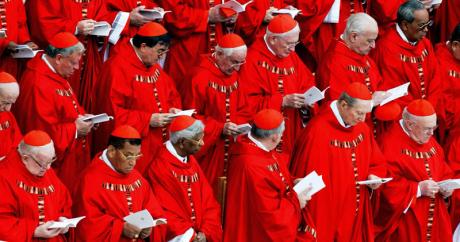 this black bastard is to blame for everything
this black bastard is to blame for everything
I’ve started reading the Confessions of Augustine of Hippo, supposedly a saint. Given to me as a Christmas present by a Christian who knows I’m not a believer. One tiny instance of an attitude common to all religious types: they can’t and won’t leave well enough alone. Useless is it, ultimately, to say that we don’t mind what absurdities these people believe in as long as they don’t foist it upon others. It’s their mission to do so – the missionary position.
I’ve read much of Augustine’s Confessions before. Needless to say, I found them far less enlightening and entertaining than Rousseau’s Confessions, but they had a human element beneath the depressing maundering about sin. The introduction to my edition, written by a Roman Catholic named R S Pine-Coffin [wonderful indication of the death instinct tendencies of that religion], starts very unpromisingly: The life of Saint Augustine has a special appeal because he was a great sinner who became a great saint…
What a world of unexamined Judeo-Christian assumptions lies behind these words. He goes on to say that Augustine, by his own admission, lived a life of sin until the age of thirty-two [not that he’s comparing himself to Jesus, he’s far too umble for that], which presumably means he led an ordinary life, until he discovered the benefits of saintliness and submission to the almighty, and all that this entails, that’s to say, hatred of the body, hatred of freedom, hatred of knowledge, hatred of progress, hatred of difference, hatred of life itself. The philosopher Michel Onfray has a somewhat different take on Augustine:
Augustine, a saint by trade, dedicated all his talent to justifying the worst in the church: slavery, war, capital punishment, etc. Blessed are the meek? The peacemakers? Augustine is no more enthusiastic than Hitler about this side of Christianity, too soft, not virile or warlike enough, squeamish about bloodshed – the feminine face of religion. He offered the church the concepts it lacked to justify punitive expeditions and massacres. These things the Jews had practiced to acquire their land, on a limited geographical scale, but the Christians drew from that local action inspiration for action across the face of the globe, for their goal was converting the world itself. The chosen people generated catastrophes that were first of all local. Universal Christianity created universal upheavals. Once it triumphed, every continent became a battlefield.
With the church’s blessing, Augustine, bishop of Hippo, sanctioned just persecution in a letter. A choice formulation, which he presents in contrast to unjust persecution! What differentiates the good corpse from the bad? Flaying of victims – when is it defensible and when is it indefensible? All persecution by the church was good, because motivated by love; while persecution directed against the church was indefensible, because inspired by cruelty. We should relish the rhetoric and talent for sophistry of Saint Augustine, who preferred his Jesus to brandish the whip and not to suffer at the hands of the Roman soldiery.
A long quotation, but necessary for us to get a sense of the man we’re dealing with, a man described elsewhere as a poster boy for religious intolerance. Onfray is scathing but accurate.
Meanwhile, our Pine-Coffin continues the hagiographic intro. After describing the irrational beliefs of the Manichees, with whom Augustine was a fellow-traveller for ten years, he remarks ‘It seems incredible that a man of Saint Augustine’s intellectual caliber could have been taken in by these fantastic theories…’. As Pascal Boyer points out in Religion Explained, secularists are continually dumbfounded by this incredulity displayed by the follower of one bizarre cult – and there are surely few more bizarre than Roman Catholicism – towards the follower of another.

poor Pelagius - victim of just persecution
In fact it’s not unreasonable to say that Augustine held out against a more reasoned, and humane, approach to Christianity in a lifetime of writing, creating a future orthodoxy out of his own cruel, self-hating preoccupations. Try this interesting and quite informative article about Augustine and Zorastrianism, Islam and totalitarianism, which dovetails nicely with Onfray’s conclusions about the fascist nature of the great monotheisms.
Pine-Coffin puts it almost gently – ‘Besides his pastoral work Augustine was a powerful adversary of all heretics and enemies of the church.’ Such a noble fellow. No mention of the ideas of these adversaries; Pelagius, at first glance a rather more humane fellow than Augustine, with a clearer and more empirical vision of human need and striving, believed that ‘grace’ could be attained outside the structures and dogmas of the Church, simply by living a Christ-like existence [he also apparently saw through Augustine’s doctrine as unregenerate Manicheism]; Donatus, who believed that if the sacraments were performed by a great sinner they would be invalid or wouldn’t work [seems reasonable to me, and the reasons given for why these ideas are ‘errors’, according to Catholic apologists, are hilarious in their tortuous rationalizations]; the Apollinarians, who held the view that Jesus wasn’t ‘really’ human, but just God poured out in human form [we all know, of course, that Jesus is ‘really’ both human and divine]; and so on. As he grew older, Augustine became more and more enamoured of the idea of using state powers to persecute these nasties [it must be remembered that Christianity became the state religion, under Theodosius, only in Augustine’s lifetime]. He set the rules for religious persecution over the next millennium or more.
Now, after all that, should I go on reading his Confessions?
Labels: the faith hope
 there are more things in heaven and earth than are ever dreamt of in your philosophy, Horrie [Hamlet's advice to a materialist mate after chatting with his dad's ghost]
there are more things in heaven and earth than are ever dreamt of in your philosophy, Horrie [Hamlet's advice to a materialist mate after chatting with his dad's ghost]










